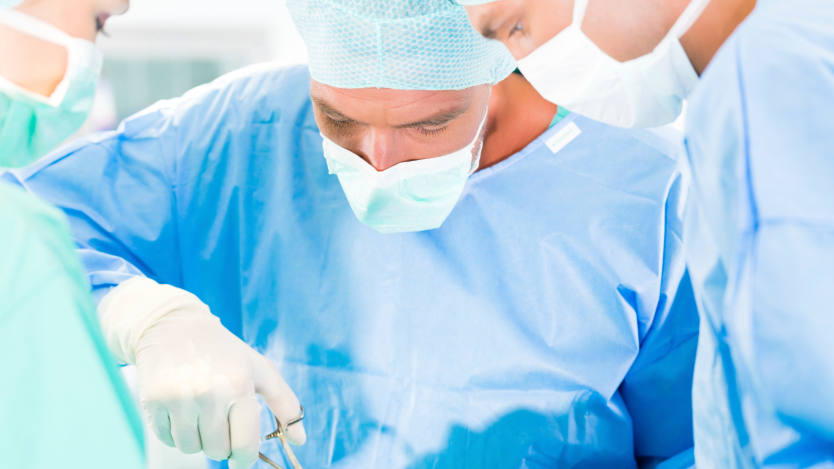Recovery time after anal fistula surgery

- What is anal fistula and what is the surgery?
- Hospital stay after anal fistula surgery
- Recovery time at home after anal fistula surgery
- Back to work after anal fistula surgery
- When to resume sexual intercourse after anal fistula surgery
- Recovery from anal fistula surgery depends on the surgical technique used, either fistulotomy or fistulectomy.
- Anal fistulas are more common in men than in women, almost twice as many cases.
- There are many aspects to bear in mind during recovery from anal fistula surgery, which we explain here.
What is anal fistula and what is the surgery?
An anal fistula is an inflammatory process secondary to an infection of the anal glands that lubricate the rectal canal during defecation.

Do you need anal fistula surgery?
Request a free and immediate appointment with our specialists in general surgery
This infection eventually forms an abscess, which is a collection of pus formed by bacteria that make up the intestinal flora, which naturally, when it reaches a certain size, ruptures and begins to empty into the skin of the anus through a fistula.
This fistula is an artificial drainage pathway from the inflamed and over-infected gland to the outside.
Symptoms associated with anal fistulas are:
- Itching and stinging in the anal area where the fistula is located.
- Irritation in the anal area where the anal fistula exit is located.
- Pain in the area where the fistulous tract is located during defecation.
- Intermittent or continuous discharge that may even stain underwear.
- In case of superinfection, fever and general malaise may occur.
In some cases, it is possible for the anal fistula to heal on its own, but when this does not happen, we must rely on the possibilities provided by anal fistula surgery.
This surgery can be performed using two techniques, fistulotomy or fistulectomy, and can be performed under regional or general anaesthesia, depending on the specialist's decision.
The two surgical techniques are explained briefly below:
Fistulotomy
Care must be taken to avoid incisions inside the anal ring to avoid the complication of faecal incontinence, although this is unusual for an experienced surgeon.
This procedure is performed under regional anaesthesia in most cases. The surgeon must assess the depth, direction and extent of the fistulous tract in order to choose the most suitable technique at that moment.
If it is decided to perform a fistulotomy, the surgeon will cut the skin and part of the sphincter muscle, leaving the fistulous tract in the air, so that it heals from deeper levels towards the outside and does not heal falsely.
It lasts approximately 30 minutes and is indicated for simple perianal fistulas.
Fistulectomy
It is indicated in cases of complex or complicated fistulas. It can be performed under regional anaesthesia, although in some cases it may require general anaesthesia.
The operation time may vary, depending on the specific case, between 30 and 90 minutes.

There are very complex cases where sphincter repair, grafting, or even redoing an artificial anus is required, although this is in very complex, but infrequent cases.
After anal fistula surgery, the patient will be taken to the recovery room to recover from anaesthesia.
Before leaving the hospital, the patient will be explained how to perform the dressings and sitz baths after discharge from the hospital.
The optimal outcome of anal fistula surgery will depend to a large extent on the surgeon's skilled hands. It is important that the operating physician has considerable experience in the surgical treatment of anal fistula.
Otherwise, inexperienced hands or hands unfamiliar with the technique could lead to disastrous complications such as partial destruction of the anal sphincter and consequently faecal incontinence.
Hospital stay after anal fistula surgery
The hospital stay in the case of a fistulotomy is zero days. The patient can go home after the operation but with specific instructions for care and treatment at home.
On the other hand, in the case of fistulectomy, the stay will be one day at most and the surgeon will make sure that the patient has understood all the post-surgical instructions.
In the case of Operarme, all patients have a one-day hospital stay so that the hospital's medical team can make sure that everything has gone correctly.
Recovery time at home after anal fistula surgery

Full recovery after anal fistula surgery depends on two main factors:
The severity of the anal fistula
The more serious the problem associated with the anal fistula, the more time will be needed for recovery as the amount of tissue treated by the doctor is greater.
The technique used in the surgery
If a fistulotomy is performed, you will be able to lead a normal life within a week and the surgical wound will heal in 4-5 weeks.
In the case of anal fistula surgery using the fistulectomy technique, recovery may take longer because the surgical wound is larger. Normal life can be resumed after 2 weeks and complete healing can be achieved in around 6-7 weeks.
Back to work after anal fistula surgery
In 90% of cases, within 15 days of the operation, the discomfort and/or pain in the anal area disappears.
Return to work can be around 4-5 weeks after the operation if the fistulotomy technique has been used and 6-7 weeks if a fistulectomy has been performed.
However, it is advisable to tell the surgeon what your profession is, so that he/she can tell you more precisely when you should return to work, depending on whether you are standing, sitting or on the move.
On the other hand, if you have to carry weight in your job, which increases intra-abdominal pressure, this will mean a few more days of recovery before you can return to work.
When to resume sexual intercourse after anal fistula surgery
Vaginal intercourse can be resumed relatively soon, as the perianal area near the vagina is not affected. It will therefore depend on the healing of the anal region and the residual peri-scar oedema, which is the swelling that occurs around the surgical wound.
This process can be fully recovered in 15 - 21 days depending on each case.
As for anal sex, you will have to wait longer. Until, in addition to the sphincter having healed, the skin covering it is sufficiently elastic so that it does not break during intercourse. Furthermore, the healing is done in planes, from the deepest to the most superficial, to avoid false healing.

When initiating sexual intercourse via the anal route, we can also differentiate according to the technique used:
Resuming sexual intercourse after fistulotomy
Healing is completed in about 4-5 weeks on average. It is recommended not to start sexual relations before this time and even to wait a few more weeks.
Resuming sexual intercourse after fistulectomy
In this case, healing may take 6-7 weeks, so it is recommended to abstain from anal intercourse during this time.
Anal intercourse before the most superficial areas of skin have healed could be fatal, because all the granulation tissue (new tissue), which has formed in depth, would be torn. The healing process would have to start all over again in a more disorganised, less clean way and with a risk of infection. This is why it is important to be sure that the healing process is complete before having anal intercourse.
It is extremely important to lubricate the area well before penetration.
The first time after surgery you should be very careful and not be in a hurry.
If intercourse is nevertheless uncomfortable or painful, wait a few more days before trying again.
Are you thinking of having private anal fistula surgery?
Remember that at Operarme we offer you a pre-surgical assessment consultation so that you can meet the surgeon and schedule the surgery as soon as possible.
You can request a free consultation or more information by clicking below:

Do you need anal fistula surgery?
Request a free and immediate appointment with our specialists in general surgery
Medical disclaimer: All the published content in Operarme is intended to disseminate reliable medical information to the general public, and is reviewed by healthcare professionals. In any case should this information be used to perform a diagnosis, indicate a treatment, or replace the medical assessment of a professional in a face to face consultation. Find more information in the links below:

